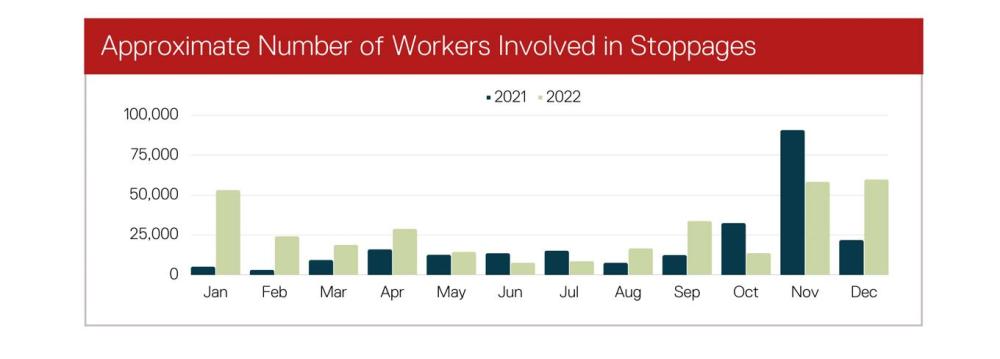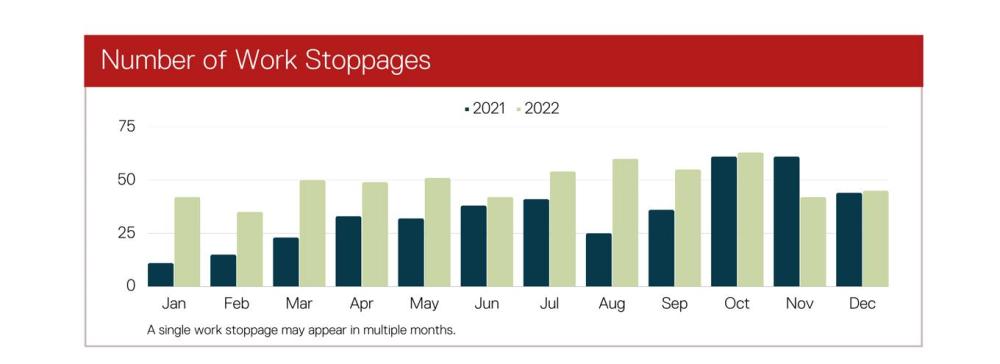We are pleased to release the second Cornell-ILR Labor Action Tracker Annual Report, which presents key findings from our data on work stoppages in 2022. We have created a comprehensive database of strikes across the United States because official data sources only record a small fraction of this activity. Since funding cuts by the Reagan administration in the early-1980s, the Bureau of Labor Statistics (BLS) excludes work stoppages of less than 1,000 workers from its database. As this report demonstrates, only recording very large work stoppages excludes the vast majority of strike activity and leaves practitioners, policymakers, and scholars misinformed about the true level of workplace conflict. Strikes remain an important source of labor activism and, at least in comparison to 2021, have increased in salience. In this report, we follow the lead of the BLS and document work stoppages, which include both strikes and lockouts. You can follow our project and view our monthly reports of strike activity on Twitter @ILRLaborAction.
Methodology
This report is based on data we collected on strikes and lockouts in 2022. Detailed information on our project’s methodology can be found here. Further details specific to the methodology for this report can be found throughout this document. We generate all our data on strikes from several public sources, including existing work stoppage databases, news articles, and social media posts. We follow rigorous verification protocols to ensure that a strike did in fact occur and to collect data on several related variables, including, but not limited to, the size, duration, industry, and demands of a strike. We link to the sources used to generate data on each strike on our site’s interactive map. We also collect data on labor protests, but only provide summaries of work stoppages in this report because our count of protests is less comprehensive. In light of our rigorous protocols, we may underestimate the total amount of work stoppages as we cannot include events that do not have adequate verifiable information.
Updated 2021 Findings
Because we occasionally find information about work stoppages months after the event occurred, we have updated work stoppage data for last year’s report. We have found 14 additional work stoppages (all strikes) in 2021 since we issued our 2021 report, so we have updated the total number of work stoppages for that year from 265 to 279. The vast majority of these events (13 out of 14) occurred in the accommodation and food services industry and were relatively small scale (all involved fewer than 50 workers). All 14 new strikes involved nonunion workers, which means that nonunion workers organized ~36% of all work stoppages in 2021. Additional updates to our 2021 data are reflected in the figures below. We do not plan on further updating data from 2021.
Key Findings from 2022
We documented 424 work stoppages (417 strikes and seven lockouts) involving approximately 224,000 workers in 2022. These 424 work stoppages resulted in approximately 4,447,588 strike days this past year. Several important findings emerge from our 2022 data. First, the total number of work stoppages increased by ~52% (279 to 424) and the total number of approximate workers involved in work stoppages increased by ~60% (~140,000 to ~224,000) from 2021 to 2022. Second, workers in the accommodation and food services industry organized more work stoppages in 2022 (144) than any other industry, accounting for over one-third of all events. However, these work stoppages involved approximately 7,000 workers, or ~3% of the total workers involved in work stoppages in 2022. The vast majority (131, or ~91%) of work stoppages in the accommodation and food services industry were led by either Starbucks workers organizing with the Starbucks Workers United campaign or fast-food workers organizing with the Fight for $15 campaign. Third, the majority of all workers involved in work stoppages came from the educational services industry (~135,380, or ~60%). Fourth, nonunion workers continued to organize a high proportion of strikes (~32%) in 2022, though these strikes were considerably smaller than work stoppages by unionized workers. Fifth, most work stoppages in 2022 were relatively short in duration, with ~46% lasting one day or less and two-thirds lasting fewer than five days.
Finally, while we documented an uptick in strikes and approximate number of workers on strike in 2022 as compared with 2021, the level of strike activity is lower than earlier historical eras. The number of work stoppages and approximate number of workers involved in work stoppage is considerably less than the most recent comprehensive BLS data from the 1970s, and the approximate number of workers involved in work stoppages falls behind recent increases documented by the BLS in 2018 and 2019. More research is needed to make meaningful historical comparisons that account for the immense challenges facing striking workers and the labor movement more broadly.
Acknowledgments
A special thanks goes to the Cornell-ILR School for funding our project and the entire Cornell-ILR Labor Action research team for putting in the hours to document strike activity. We thank the staff at Cornell-ILR’s Worker Institute, who have continued to support and promote our project since our public launch in May 2021. We would also like to thank David Yantorno and Betsy Wiggers of Cornell-ILR’s marketing team, Mary Catt of Cornell-ILR’s communications team, and David DeMello of Cornell-ILR’s web development team for their excellent design and promotion of our report. We also thank the Washington Center for Equitable Growth for funding that has helped support and inform our project over the past six months.
Number of work stoppages and approximate number of workers involved in stoppages per month
In 2022, approximately 224,000 workers were involved in 424 work stoppages (417 strikes and seven lockouts), for a total of 4,447,588 strike days. The number of work stoppages each month stayed relatively consistent, except for a slight increase in stoppage activity between July 2022 and October 2022. In comparison to 2021, which had a total of 279 work stoppages, with approximately 140,000 workers on strike for 3,269,186 strike days, there were 145 more work stoppages with approximately 84,000 more workers on the picket line.


Click Here to read the full report on-line.
Click here to download the full report.
Johnnie Kallas, PhD Candidate, Cornell University ILR School
Kathryn Ritchie, BSILR ’24, Cornell University ILR School
Eli Friedman, Associate Professor of International & Comparative Labor, Cornell University ILR School


Spread the word